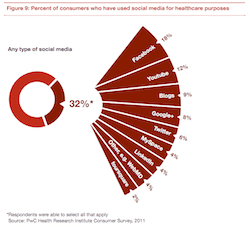Doctor Marketing Tip: Your Disappearing Patients and How to Reach Them
 The recent report from accounting firm PwC—Top Health Industry Issues of 2012—is near the top of our recommended reading list for marketing savvy physicians and healthcare marketing professionals. Thought leaders—providers, group practices and hospitals—will want to take note of two interconnected findings that jump out of the data.
The recent report from accounting firm PwC—Top Health Industry Issues of 2012—is near the top of our recommended reading list for marketing savvy physicians and healthcare marketing professionals. Thought leaders—providers, group practices and hospitals—will want to take note of two interconnected findings that jump out of the data.
First, there’s the problem of the “disappearing patient.” PwC shows how upwards of 50 percent of responding adults have deferred care in the past year because of cost. (Check out this interactive graph with the PwC report here.) There’s no surprise in these numbers in general. It’s a confirmation of the widely felt experience of many people in medical practice marketing...many people are reluctant to seek healthcare.
What’s more interesting is that the numbers begin to quantify and identify the disappearing patients. According to this survey, it is the younger age categories of adults (18-24 and 25-34) who have deferred care in the past, and presumably are most inclined to stay on the wellness sidelines.
Secondly, you can reach these same age groups using social media. PwC reports “younger people were more likely to use social media than older people for healthcare purposes. Overall, nearly a third of respondents, and 50 percent of those under the age of 35, had used social media for healthcare purposes, which can range from registering a complaint to looking up informational videos on YouTube.”
Consumer choices reveal preferences that can guide healthcare marketers in the choice of preferred resources. Among the consumers who have used social media for healthcare purposes, Facebook (18%), YouTube (12%) and blogs (9%) are clearly the popular leaders. Last among the consumer’s choices are LinkedIn (4%), Other (4%) and foursquare (2%).
Further, PwC predicts an up-tick in healthcare social media. Perhaps optimistically they contend that for providers and consumers, healthcare is “no longer social media’s wallflower. In 2012, health industry organizations will connect in new ways with each other and their consumers as they wade through economic, regulatory, and political uncertainty. Some are stepping forward in cooperation; others are rewriting the rules of competition.”
PwC is realistic in acknowledging the well-known adoption barriers such as privacy issues, ambiguous regulations and other influences. (It leaves us wondering about how quickly healthcare in social media will get the necessary traction to support their 2012 prediction of meaningful growth.)
Nevertheless, the PwC report suggests that many of the patients who are among the missing can be found over there on the sidelines. And for medical practice marketing, social media is a primary—and perhaps growing—communications channel to reach them.
For more on this topic, there’s a related article about social media adoption here.








